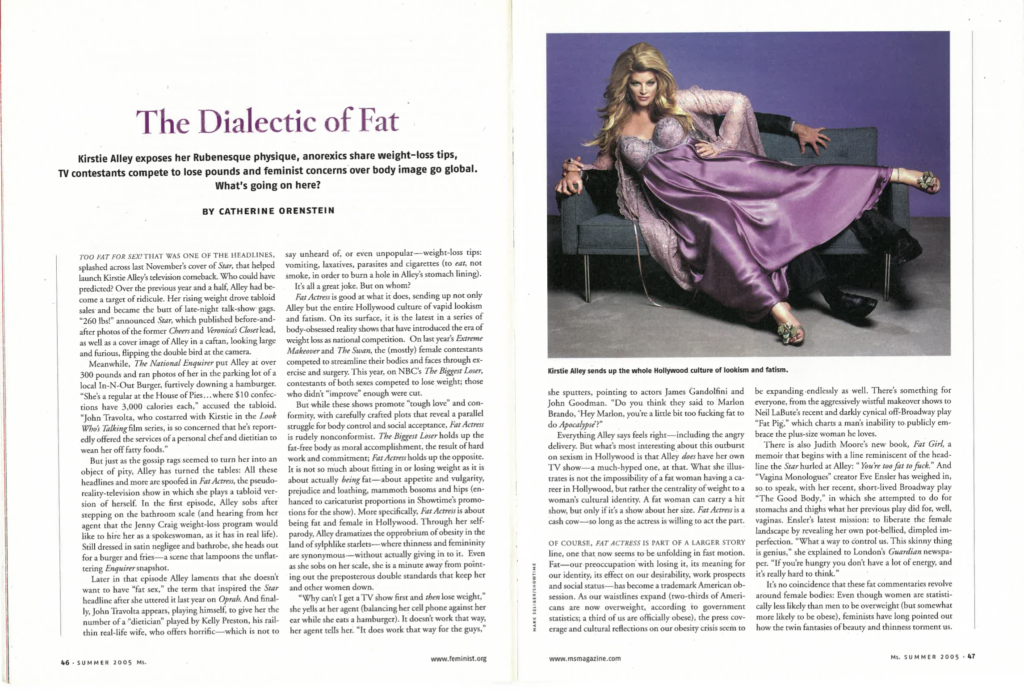
To pay tribute to five decades of reporting, rebelling and truth-telling, From the Vault includes some of our favorite feminist classics from the last 50 years of Ms. For more iconic, ground-breaking stories like this, order 50 YEARS OF Ms.: THE BEST OF THE PATHFINDING MAGAZINE THAT IGNITED A REVOLUTION (Alfred A. Knopf)—a stunning collection of the most audacious, norm-breaking coverage Ms. has published.
From the Vault: ‘The Dialectic of Fat’ (Summer 2005)
Fat––our preoccupation with losing it, its meaning for our identity, its effect on our desirability, work prospects and social status––has become a trademark American obsession. As our waistlines expand (two-thirds of Americans are now overweight, according to government statistics; a third of us are officially obese), the press coverage and cultural reflections on our obesity crisis seem to be expanding endlessly as well. There’s something for everyone, from the aggressively wistful makeover shows, to Neil LaBute’s recent and darkly cynical off-Broadway play Fat Pig, which charts a man’s inability to publicly embrace the plus-size woman he loves.

It’s no coincidence that these fat commentaries revolve around female bodies: Even though women are statistically less likely than men to be overweight (but somewhat more likely to be obese), feminists have long pointed out how twin fantasies of beauty and thinness torment us.
- The late Andrea Dworkin saw the battle of the sexes as waged on the female body in an unbroken history of oppression extending from ancient foot binding to modern-day waxing, tweezing and dieting.
- Naomi Wolf, in The Beauty Myth, exposed the staggering amount of time, effort and money that women are compelled to spend on their outward appearance in order to be socially acceptable, employable and manageable.
- Susie Orbach, in her 1978 classic, Fat Is a Feminist Issue, saw story lines playing out women’s flesh. She presented food as language and fat as a metaphor––a filter between us and the world, telling a story about our relationship with our mothers, men and ourselves. She urged women to stop dieting and instead seek to understand the reasons why they were fat in the first place. Fat, she wrote, has hidden agendas and can express many things: the desire for protection, to remain unseen, or to rebel against imprisoning social ideals.
But whatever wisdom we might have absorbed about the tyranny of the health and beauty industry and its relentless glorification of thinness seems to have had a limited, and ambiguous, impact. Today, eating disorders affect five to 10 million Americans, most of them women. Time reports that 80 percent of children have been on a diet by the time they reach the fourth grade. According to one survey, 40 percent of women would trade three to five years of their lives to achieve their goal body weight. Meanwhile, the ideal body has become even more narrowly defined, even as it is presented as increasingly accessible to all.
Part of the torment of fat, and fatism, is how it grows. Dominant American (read: privileged and white) body ideals have spread along with our pathologies. Despite the conventional wisdom about African American and Latino cultures’ appreciation for more voluptuous female body types, eating disorders are on the rise for both those groups.
We are also exporting our body issues to faraway places, with disturbing success. Studies funded by Harvard Medical School tracked the eating habits of girls on the island of Fiji, where television was first introduced in 1995. Between 1995 and 1998, the islanders watched Melrose Place and Beverly Hills 90210, and 11 percent of the girls surveyed developed bulimia––a disease previously unknown to them. Television, it seems, can carry disease.
That is not to say those affected were unwilling victims. “The girls were articulate and explicit about why they were making themselves throw up,” said the Harvard medical anthropologist Anne Becker, who led the study. “They felt that if they had a Jennifer Aniston body, they would look more modern and more Western, and they would have a better chance of getting a job.” Their dream job? “Stewardess.”
“Not only is fat a feminist issue,” Susie Orbach comments, “now it’s a global feminist issue.”
In an introduction to the 1990 reedition of her book, Orbach wrote enthusiastically about the progress that women had achieved since she had penned Fat Is a Feminist Issue 12 years earlier. But today Orbach––a psychotherapist and co-founder of the Women’s Therapy Center Institute in New York City––is less optimistic. She said she underestimated the extent to which young women are “assaulted by visual culture––by mono-imagery.” She also worries about the “normalization of disordered eating: that is, compulsive eating and dieting that is no longer considered abnormal.”
Several forthcoming books, and substantial anecdotal evidence, echo Orbach’s worries as we see the emergence of “pro-ana” websites created to support anorexics not in gaining weight but in more effectively starving themselves. (Visitors can click on “thinspiration” photos or seek tips on eating fewer than 400 calories a day.)
Fortunately, as an intriguing new anthology points out, the stories fat tells us aren’t written in stone. In Fat: The Anthropology of an Obsession, 13 anthropologists and an activist tell a few lesser-known plots.
In Niger, Rebecca Popenoe writes, desert Arabs idolize fat bodies, girls are force-fed, and women don extra clothing before stepping on the scale; stretch marks are beloved. In the world of fat pornography, Don Kulick observed, astonishingly obese women are eroticized as goddesses: Instead of having sex, they have food. And in hip-hop culture, Joan Gross reminds us, girth is a sign of power. The term “phat” seeped into that culture through music, and its original meaning––a full, rich sound––expanded to an expression of general praise.
Indeed, it’s hip-hop that provides the pseudo-reality show Fat Actress with one of its more memorable scenes: At the end of one episode, as credits roll, Kirstie Alley does a lap dance for the singer Kid Rock, accompanied by the Sir Mix-A-Lot song “Baby Got Back.” “I’m tired of magazines / Sayin’ flat butts are the thing,” go the lyrics. “I like big butts!”
After the deluge of tabloid photos and headlines that shouted Alley’s weight as if it were a national threat, it’s hard not to like a woman who dances to that. At the same time, it’s worth noting that the lyrics––like the tabloids––are fixated on her fat.
Up next:
U.S. democracy is at a dangerous inflection point—from the demise of abortion rights, to a lack of pay equity and parental leave, to skyrocketing maternal mortality, and attacks on trans health. Left unchecked, these crises will lead to wider gaps in political participation and representation. For 50 years, Ms. has been forging feminist journalism—reporting, rebelling and truth-telling from the front-lines, championing the Equal Rights Amendment, and centering the stories of those most impacted. With all that’s at stake for equality, we are redoubling our commitment for the next 50 years. In turn, we need your help, Support Ms. today with a donation—any amount that is meaningful to you. For as little as $5 each month, you’ll receive the print magazine along with our e-newsletters, action alerts, and invitations to Ms. Studios events and podcasts. We are grateful for your loyalty and ferocity.





